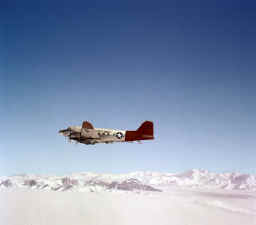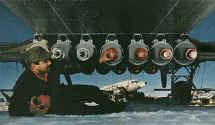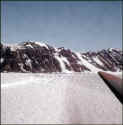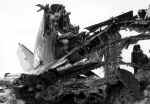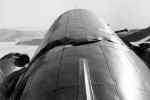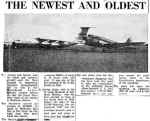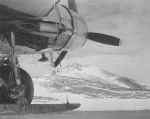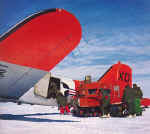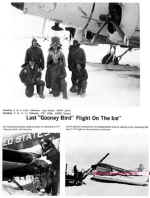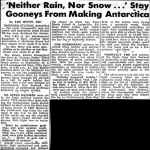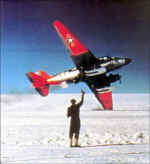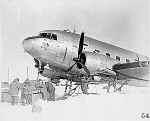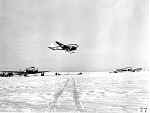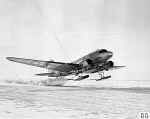-
- Douglas Aircraft
- C-47 / R4D / C-117
- Skytrain / Dakota / Gooney Bird
|
-
- Photo by James Waldron
- R4D heading south to Beardmore, September 1957
|
-
- There is some conflict in the various sources of information used to
piece together the information used to document the VX-6 R4D aircraft.
- As always I am open to corrections and new information.
-
- The following sources of information were used:
- Joe Baughers list of US Navy / US Marine Corps BUNO's.
- Jack McKillop's web page on the Douglas R4D.
- The Douglas Aircraft on-line Production List.
- United States Aircraft Losses in Antarctica and Deep Freeze Aviation Losses in
Antarctica from the Antarctic Journal / The National Science Foundation.
- Gateway to the Ice by Tony Phillips.
- Last but not least all of the guys from the Yahoo Groups OAE and FNG list who either
flew, crewed or maintained the Gooney's of VX-6 who have helped.
-
- Of the eighteen VX-6 Gooney Birds:
- All were originally built as US Army Air Force C-47A's or C-47B's during WWII.
- All were transferred to the US Navy and US Marine Corps during WWII.
- Twelve were designated by the Navy as R4D-5's, five were designated as R4D-6's and one
was designated as an R4D-7.
- Seven had been converted to R4D-8 (Super DC-3) specifications in the early 50's.
- Of those seven Gooney's five were converted R4D-5's, one was a converted R4D-6 and one
was a converted R4D-7.
-
- Actual Gooney's of VX-6:
- Six R4D-5L's
- Five R4D-6L's
- Seven R4D-8L's
-
- Differences in the eighteen:
- The R4D-5 was identical to the R4D-1
except being equipped with a 24-volt electrical system and improved cabin heating.
- The R4D-5L was modified to include extra fuel and higher gross weight for
use in Antarctica.
-
- The R4D-6's were identical to the R4D-5 but were equipped with two 1,200
hp Pratt & Whitney R-1830-90C engines with two-stage,
- two-speed superchargers, provisions for fuel tanks in the fuselage and
improved heaters.
- These aircraft had been developed for high-altitude flights over the
"Hump" in the China-Burma-India (CBI) Theater.
- The R4D-6L were further modified with extra fuel and higher gross weight
for use in Antarctica.
-
- The R4D-7 was the same as the R4D-6 except it was built for use as a
navigation trainer.
-
- The R4D-8 (Super DC-3) was a reworked DC-3 that included a strengthened
and stretched fuselage, new horizontal and vertical tail
- surfaces with squared tips, squared wing tips, smoother engine nacelles
with doors that completely enclosed the landing gear and more
- powerful 1,475 hp Wright R-1820-80 radial engines.
-
- What is an R4D, a C-47, a C-117 and why?
- Before the adoption of the Tri-Service system in 1962, the US Navy had its own system of
aircraft designations, completely different from
- that used by the USAAF and USAF.
-
- The Navy system consisted of up to five parts:
- One or two letters to indicate the function of the aircraft.
A sequence number, to distinguish between aircraft of the same function built by
the same manufacturer.
- A letter to indicate the manufacturer.
- After a dash, a number to indicate a subtype.
- A letter to indicate a minor variation on a subtype.
-
- This is how the R4D-5L was identified in Navy speak:
-
- R = Transport (type aircraft)
- 4 = Fourth type in the series from the manufacturer
- D = Douglas (manufacturer)
- (after the dash)
- 5 = Subtype of the model
- L = Cold weather operations
-
- The R4D-5 in USAF speak was called the C-47A.
-
- The USAF designation consists of a letter (or set of letters) indicating the type /
mission of the aircraft, and a sequence number indicating a
- specific aircraft within a category, separated by a dash.
- The number may be followed by a series letter to indicate a variant of an aircraft.
-
- C = Cargo transport
- 47 = Sequence number (for USAAF cargo transport aircraft)
- (after the dash)
- A = Variant of model
-
- On September 18, 1962, the Defense Department ordered that all Air Force, Army, and Navy
aircraft be designated under a common, universal system.
- This was done because Secretary McNamara was interested in achieving greater commonality
between the services.
- According to one story, he supposedly had gotten hopelessly confused when his aides told
him that the Navy and the Air Force had completely different
- designation schemes, often for what was basically the same aircraft.
- Under the Defense Department order, the separate naval designation system which had been
around since 1922 was eliminated.
- Thus was born the Tri-Service system of 1962.
-
- The R4D-5L became the LC-47H.
- The R5D-6L became the LC-47J.
- The R4D-8L became the LC-117D.
-
- Why was the R4D-8 a C-117 and not a C-47?
- Due the major modifications that were done to the R4D-8 it was deemed
"different" enough to be considered a new type of aircraft.
- The USAF tested the prototype Super DC-3 as the YC-129-DO.
- The USAF later changed the designation of the YC-129-DO to YC-47F-DO.
-
|
-
- 12407
- C-47A / R4D-5 / C-47H / LC-47H
- "Us Know How"
- 12407 Information Link
|
Crashed on the Lillie Glacier,
Antarctica 22 October 1964. |
- 12418
- C-47A / R4D-5 / R4D-5L / LC-47H
- "Que Sera Sera"
- "Korora"
- 12418 Information Link
|
-
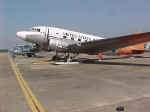 - Photo by Gus Shin
- Loaned by the Smithsonian, on display at the National Naval Aviation Museum, Pensacola, FL.
|
-
- 12441
- C-47A / R4D-5 / R4D-8L / LC-117D / N105BF
- "City of Invercargill"
- 12441 Information Link
|
- Currently for sale minus engines, avionics and interior at DMI Aviation, Tucson, AZ as
scrap.
|
-
- 17092
- C-47A / R4D-5/ R4D-8L / LC-117D / N110BF
- "Would you Believe"
- 17092 Information Link
|
- Currently for sale minus engines, avionics and interior at DMI Aviation, Tucson, AZ as
scrap.
|
-
- 17107
- C-47A / R4D-5 / R4D-5L / LC-47H
- “Ahab’s Clyde” / "Deep Freeze Express"
- 17107 Information Link
|
- Crashed in the Horlick Mountains, Antarctica on 5 December 1965.
|
- 17154
- C-47A / R4D-5 / R4D-8L
- “Negatus Perspirus”
- 17154 Information Link
|
-
 - Photos from William Staskel
- Crashed during landing at Byrd Station, Antarctica Dec 24, 1960.
|
- 17163
- C-47A / R4D-5 / R4D-5L
- "Takahe"
- 17163 Information Link
|
-
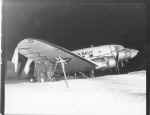 - Broke landing gear on landing at Camp Hallett, Antarctica Sept 15, 1960.
|
-
- 17188
- C-47A / R4D-5 / R4D-8L / LC-117D
- "Lou Bird II" / "Big Daddy" / "The Losers"
- 17188 Information Link
|
- Crashed on Sentinel Ridge, Antarctica on 22 November 1962.
|
-
- 17219
- C-47A / R4D-5 / R4D-8L
- "Semper Shafters USMC"
- 17219 Information Link
|
- Aircraft abandoned at Horlicks, Ellsworth Land, Antarctica.
|
-
- 17221
- C-47A / R4D-5L / LC-47H / LC-47M
- "Kool Kiwi" / "Yankee Tiki A Te Hau" /
- "Mutha Goose" / "The Emperor"
- 17221 Information Link
|
-
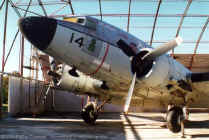 - Photo by Phillip Treweek
- On display at the Ferrymead Aeronautical Society, Christchurch, New Zealand.
|
-
- 17239
- C-47A / R5D-5 / R4D-5L / LC-47H
- "SNAFU" / "Hallmark"
- 17239 Information Link
|
-
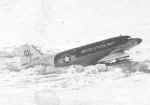 - Crashed 6 October 1965 at Williams Field, Antarctica.
|
-
- 17246
- C-47A / R4D-5 / R4D-5L
- "Torono II” / "Little Horrible" / "Korora II"
- 17246 Information Link
|
- Withdrawn from use in May 1961, struck from the Navy Record.
|
-
- 17253
- C-47B / R4D-6 / R4D-8L / LC-117D
- 17253 Information Link
|
In December 1979 the aircraft was at
MCAS Iwakuni, Japan. |
-
- 17274
- C-47B / R4D-6 / R4D-6L
- "Charlene" / "Tawaiki"
- 17274 Information Link
|
Left on an iceflow in the Ross Sea,
Antarctica in 1962 for disposal. |
-
- 50777
- C-47B / R4D-6 / LC-47J
- 50777 Information Link
|
- Crashed Davis Glacier, Antarctica on 25 November 1962
|
-
- 50778
- C-47B / R4D-6 / R4D-6L / LC-47J
- "Gotcha"
- 50778 Information Link
|
- Crashed on Shackleton Glacier, Antarctica 11 January 1965.
|
-
- 50832
- C-47B / R4D-6 / C-47J / LC-47J
- "Spirit of McMurdo"
- 50832 Information Link
|
- Crashed on the Ross Ice Shelf, Antarctica on 2 February 1966
|
-
- 99853
- TC-47B / R4D-7 / R4D-8L / LC-117D
- “Wilshie Duit” / "Devine Wind"
- 99853 Information Link
|
-
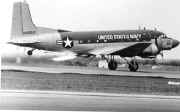 - While being loaded on a ship in Mcmurdo the aircraft fell from the crane and was struck.
- The aircraft was pushed out on the ice to drift away and sink.
|
-
|
-
-
- -- Ray Berger reberger@fnbnet.net wrote:
The following types and bunos are listed in my log book while aboard VX6: C117D 138820.
LC117Ds 17191, 99853, 12441, 17253 C47J 50753, 50766. LC47H 17017, 17221. It is curious
that all have 5 no.s except 138820 which is listed as a C117D. That was strictly a Quonset
bird, I think, as were the C47Js 50753 and 50766, at least that is where I flew
them.
Ray
-
- -- Ray Berger reberger@fnbnet.net wrote:
Looking at my logs, I flew my first R4D-5 in June 1952 Buno 17108 in the ferry squadron
VRF 32. I took it from Jacksonville to San Diego. After that I have flown R4D5s 39062,
50780, 56528, 50854, 17134, and 39095 R4D-6s Bunos 17257, 50800, 17119, 50761,50979,
39098, 50836, and 50775. R4D-7s 99833, 99826. My earliest R4D-8 was in 17219 in May
1953. Also R4D-8s Bunos. 172421, 17292, 17177, 17124, 17149, 17191(this appears
later as a C-117D), 17152, 17190, 50826, 99845, 17127. C-117D 17248 in June 1963, first
time that designation appears in my log. I aso flew C-117Ds 99845, 39061. I have a
C47 J listed with Buno. N7998A. I delivered it from Norfolk to Naples Italy via Goose Bay,
Keflavic, Prestwick Scotland and London. I almost caused an international incident
when I filed direct London-Naples. When I hit the Swiss border I was asked if I had
overflight clearance. Nobody violates Swiss airspace and keeps his career intact. So I did
a quick route change. That looks like a civilian number and was delivered to the US
embassy in Naples. All the rest in my logs(I have 5 with 8448.1 hours) are C47s and C117s
in VX6
Ray
-
- --From: "Paul K. Panehal" panehalp@fdn.com
The aircraft which went down in Jan/Feb 66 was a 47 and it caught a wing tip on landing.
Dick Simmons the radioman on the flight and I were close friends. Shaddock (sp) had taken
Red Auxfords place on that flight. Red was that crew's FE/PC.
- I believe the fill in pilot was to be the winter-over OinC of the VX-6 group. VX-6 had a
very small WO group that year, smaller than previous years - no requirement to fly a 47 or
117. I was to be the WO radioman for the 47/117's and was scrubbed from the WO roster.
That was one of the reasons I was choose to be one of the crew to fly 17221 back to the
Ice
- in the 66-67 season.
-
- --From: Bill Spindler spindle@attglobal.net
Back to the 1/74 Antarctic Journal...
"The fourth airplane loss of the season occurred on January 12, 1965, at Camp Ohio in
the Horlick Mountains. An LC-47J (Buno 50778) was at landing rollout on the skiway
when one of the main skis struck a high but unobserved sastrugi. The ski turned vertical
and struck the propeller, tearing off the engine and twisting the fuselage."
[this BUNO isn't on Joe's list either]
No crew member names are mentioned in the article for either of the 2 64-65 LC-47 losses;
generally the article ("US aircraft losses in Antarctica" by Peter J.
Anderson, NSF OPP) only names fatalities.
-
- --From: "Paul K. Panehal" panehalp@fdn.com
It was LC-47, last part of Buno was 832 (possibly 17832). The accident occurred Feb
3, 1966 at 0942 hrs Zulu on the Ross Ice Shelf near Roosevelt Island. Lt. Harold
M."Hal" Morris was plane commander, Lt. William D. "Bill" Fordell
copilot, Lcdr Ronald Rosenthal navigator, ADJ3 Charles C. Kelley and ADR3 Wayne M.
Shattuck plane captains, and Richard S. "Dick" Simmons AT1 radioman. The
accident was observed by the crew of an LC-117 (Buno last three 107 if I am not mistaken.
I believe Jimmy Clark ATR2 was it's radioman - during his pre C-121J years) which was
there at the time. Exploding JATO due to the intense heat destroyed all but the tail
section, and continued to explode for hours after the accident.
Wasn't Wayne Shattuck normally part of the Otter crew? For two reasons this accident has
been etched in my memory. One Dick and I were good friends. He and I had dinner together
the evening before the accident. He was helping me with binary (which seems so old today)
and we discussed electronics theory. A short while after dinner he was not feeling well
and had gotten sick to his stomach. He thought something he ate didn't agree with him, and
went to his rack.The following morning (day of the accident), I was coming out of the AT
shop at Willy Field and caught my wedding band on the door as I went slipped down the
steps to the snow. The edge of the door ripped my ring off my finger, taking with it a
good bit of skin both above and below the knuckle on my left hand, ring finger. I remember
being on my hands and knees for some time, digging in the snow trying to find the ring,
and my finger bleeding like crazy. After some time I found the ring I wrapped my finger in
a handkerchief and headed over to the sickbay. Just as I was checking in to see the Doc
(Doc Holik)and the radio went off, announcing the plane crash and telling the emergency
medical crew a LC-130 was standing by to fly Doc Holik and his party to the crash site.
Everything went into high gear getting the equipment and personnel ready and out the door.
It may have been a half hour or longer before everyone settled down enough to take care of
my finger. I'm sure Doc and his group were outa there within minutes of the call but, all
of us were concerned about the who and extent of the accident. All the particulars were
not known as those in the know cut-off circulation of all information. Later, when the
LC-117 returned I found out from Jimmy what he had seen and what had happened. Still, the
information was not available to everyone. I think, the reason I was told, was due to our
friendship. I was sick, when I discovered Dick was on-board. They also reported that Doc
Holik efforts were dedicated and relentless. He just would not give up in his efforts,
although others resolved there was nothing that could be accomplished. Doc was highly
revered even before this situation, and became almost legendary afterwards. I have never
known a more dedicated doctor, in my 30 years of service. My hat has, and always will, be
off to the "Real Quack" of VX-6, and the many things he did on the Ice to make
the everyday fatigue disappear. Those who served with him will always remember the picture
on the door to sickbay with a duck dressed as a doctor and the words "VX-6
Quack". Thanks Doc.
Hope this helps out.
-
- --I just ran across an old pix of LC-47 17239 #8 JD ("Snafu"?), after it was
stricken. I believe it was the LC-47 which caught a ski in snow contorted waves -
sastruugi (sp?) - (caused by wind, resulting in a very rough surface - sort of like an
aircraft with pontoons landing in heavy sea waves). Location in the Horlick
Mountains half way between Byrd and Pole Stations. This occurred early in the season and
no one was hurt, other than the A/C. Or it could be the aircraft which put a prop through
the port fuselage. In any case no one was hurt in either accident. Dick Andersen or Ray
may be able to fill in additional blanks.
pk
-
- --BUZSAM@aol.com
Hi, Joe, I'll try to answer (to the best of my knowledge and reference material at hand)
some of your questions concerning side numbers of R4D's.
#1 BUNO 17246 R4D-5 Name: Korora II
#2 ? (however, P2-V 140436 was side numbered 2 ; also BUNO 140437 was side numbered 1.
Confusing, huh?)
#3 ?
#4 BUNO 17274 R4D-5 Name: Charlene
#5 BUNO 56528 R5D-3 Admiral's plane
#6 BUNO 56505 R5D-3 Name: Have Gum, Will Travel
#7 BUNO 17163 R4D-5 Name: Takahe - also: BUNO 17188 R4D-8
#8 BUNO 12418 R4D-5 Name: Que Sera Sera - also: BUNO 17154 R4D-8
#9 BUNO 17219 R4D-8 Name: Semper Shaftus USMC
#10 BUNO 99853 R4D-8 Name: Wilshie Duit - later: Divine Wind Also: BUNO 131624
R7-V Name: Phoenix was also #6
- I picked up 50835 at the plant in Santa Monica after it was modified to an R4D--8 for
VR-22 in April of 1952.
- A listing of all the R4D-8's that I have flown:
-
- VR-22
17116
12438
17177
39104
39109
17216
17150
50834
39087
17160 which I had flown as an R4D-5 before modification
|
VR-24 17273
50762
17102 |
Qounset Point:
17111
17154
17219
99853 *
17188
17255
50831 |
|
|
-
- ODE TO THE LAST OF THE R4D GOONIE BIRDS
By Billy-Ace Penguin Baker
-
- Puckered Pete's Antarctic Newseum
- - R4D History and Sea Story links
-
- Flight of the Puckered Penguins
- Commander James Edgar Waldron, U. S. Naval Reserve (Ret.)
-
- Boeing Douglas DC-3
-
- DOUGLAS R4D
by Jack McKillop
-
- The DC-3 Hangar
-
- The Online DC-3 Aviation Museum
-
- Basler Turbo Conversions
-
|

